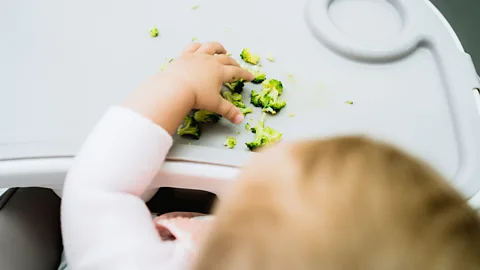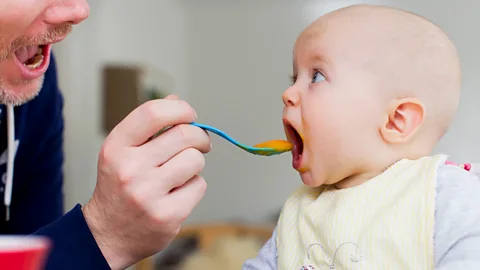Baby-led weaning: What are the risks and benefits?
 Getty Images
Getty ImagesAllowing your baby to self-feed is said to help them broaden their palate and control their appetite, but does the evidence back that up – and is it safe?
Picture an infant fed her first meal of solid food. If you live in a Western, industrialised country, one image might particularly come to mind: a baby sitting in a high chair, spoon-fed puree by a doting caregiver.
But since the early 2000s, growing numbers of parents have been adopting a different approach – one where the child gnaws away on a head of broccoli, corn on the cob or even beef rib, without any caregiver help at all. Often referred to as "baby-led weaning" (BLW), this alternative allows children to self-feed, without using utensils, on family foods that are cooked and cut to be safe for infants.
Popularised in 2008 by public health nurse and author Gill Rapley and promulgated by dozens of baby books, nutritionists, and social media accounts, baby-led weaning has seen an increase in parent interest in countries from Brazil to France. "This is a social media driven invention," says Mark Corkins, chair of the Committee on Nutrition at the American Academy of Pediatrics.
Advocates say there are many benefits, from helping children better regulate their appetites to fostering more adventurous eating. But does scientific research bear these findings out? And, perhaps most importantly, is BLW safe?
A difficult area of research
One challenge in assessing the pros and cons of weaning methods is the lack of high-quality research. For example, a 2022 review by the Committee on Nutrition of the French Society of Pediatrics found that, from 2000 to 2021, there were only 13 studies published on the risks versus benefits of BLW.
An additional challenge is that how someone feeds their child generally reflects numerous other characteristics of a family. That means it's hard to know if the outcomes of observational studies are due to the weaning method or something else. Most BLW research has been observational, including 11 of the 13 studies in the French review, meaning it can be hard to unravel other confounding factors that might explain differences. For example, families that pursue BLW tend to breastfeed for longer and have higher levels of education.
 Getty Images
Getty ImagesEven the findings of a randomised controlled study – in which one group of parents is given BLW instructions and a "control" group is given traditional feeding advice – must be taken with a grain of salt, the 2022 review warns. "This is a problem of all studies on nutrition – you cannot randomise," says Jean-Pierre Chouraqui, coordinator of the Committee on Nutrition of the French Society of Pediatrics and one of the co-authors of the committee's review. For example, some parents given BLW instructions may find themselves unable or unwilling to follow them. As a result, even the parents who ultimately do adhere to BLW could be different sorts of parents than the control group. It's also difficult for researchers to know if families truly followed these methods for every meal.
Confounding matters further, particularly in studies in which parents self-report whether they used BLW or not, is the confusion over what BLW really is. One unpublished survey conducted by the French Association of Ambulatory Pediatrics that was cited in the French Society of Pediatrics' review found that 26% of parents in France said they did BLW with their children. But when questioned, it turned out that just 7% of these parents were following all the BLW tenets: for example, many of them used a spoon or purees at least some of the time.
What – if anything – can we conclude from the research that does exist?
Baby-led upsides
First, there are the benefits for families themselves. Studies have found that families practicing baby-led weaning tend to eat more often together. They also find mealtimes calmer and less stressful. Meanwhile, mothers who do BLW say they feel less pressure and worry around weaning than those who traditionally wean.
However, these factors could at least partially result from the types of caregivers who pursue BLW, rather than BLW itself. A parent with a more relaxed approach to mealtimes, and who values having family meals together, might be more likely to do BLW.
There are also purported benefits for infants from BLW. Since infants self-feed, proponents say it helps them to learn to listen to their bodies and stop eating when full. This could, theoretically, lead to a lower longer-term risk of conditions like obesity.
Some research bears this out. Observational studies have found that BLW infants appeared to have more awareness of when they were full and were less likely to be overweight (although this study relied upon a questionnaire completed by mothers). This difference has been found by other studies to persist into the preschool years, even after variables like socioeconomic status were taken into account. However, one randomised controlled trial of 206 infants in New Zealand found no difference in infant weight or appetite regulation.
Another argument is that, by being exposed to more flavours and textures earlier, BLW babies become more adventurous eaters. The New Zealand trial did find this. It tested a "modified" version of BLW, in which parents offer one high-iron and one high-energy food at each meal. Parents who did this reported their infants were less fussy and enjoyed food more than the traditionally weaned infants. Another analysis of the same cohort found that, by age two, the modified BLW infants consumed a higher variety of fruit and vegetables than the other babies. However, they were no more likely to eat a larger variety of foods in other groups, like meat and fish.
Still, researchers point out that potential benefits of BLW, like early exposure to textures, should also be experienced in traditional weaning.
"We don't recommend doing purees from six to 12 months. Nobody recommends that," Corkins says. "What's recommended is that the purees are only at the very, very, very beginning." Solid "morsels" of food ideally should be offered by eight months, he says. Infants should be eating the same sorts of foods – and be similarly adept with textured and solid foods – by around one year of age, no matter how they were weaned.
Weaning risks
One concern, no matter the weaning method, is choking. Babies have some protective reflexes against choking. They include gagging, often mistaken for choking, which is triggered more easily (towards the front of the mouth) the younger they are. The protective reflexes should occur regardless of whether they are consuming a puree or safely cut food. Yet choking remains a real risk.
The limited research indicates little risk difference between BLW and other forms of weaning. Another analysis of the New Zealand cohort found that both gagging and choking were common in infants between six and eight months of age – but that incidences of both were equally likely regardless of whether they were fed purees or did BLW. It's important to note that, in that study, parents were given instructions on how to prepare foods to be less risky for choking, and which to avoid completely. A large observational study of 1,151 infants found the same.
Another concern is that self-feeding babies may not eat enough, or get enough of the nutrients they need. One observational study found that BLW infants were more likely to be underweight. In contrast, the New Zealand RCT – which told parents to offer high-energy food at each meal – did not.
You may also like:
Because BLW encourages babies partaking in family meals, infants could end up consuming too much salt or sugar. As a result, caregivers should mindful of how they both prepare and offer food, says Corkins. "I always have a little bit of a concern, to be honest with you, because we're born with two preferences in our taste buds: we like sweet, and we like salty," he says. "Now, are sweet and salty always good for us? If you put a strawberry on my tray and a piece of broccoli on my tray, which one am I going to put in my mouth? Now the parent has to control this. So maybe what they have to do is just put broccoli on the tray."
What about nutrients? One very small study involving 51 babies found that, while both BLW and traditional-weaning infants generally consume around the same amount of energy, those who fed through BLW had lower intakes of iron, zinc and vitamin B12. However, other research has found that parents who follow strict BLW are more likely to offer iron-rich foods than traditionally weaning families. When the modified version of BLW that emphasised giving iron-rich foods was assessed in the New Zealand studies, there was no difference in infants' iron intake at 12 months, or of measures of iron status in the blood such as haemoglobin levels.
 Getty Images
Getty ImagesDespite these encouraging findings, the differences between BLW and traditional weaning families give nutritionists like Chouraqui pause before recommending BLW to all families. Currently, parents who pursue BLW tend to research the nutritional requirements, he says. But as it becomes more mainstream, that may change, with more infants potentially being exposed to nutritional imbalances. Indeed, this may already be happening: one study found that parents following a "looser" version of BLW were four times as likely to give their babies savoury snacks like crisps and crackers compared to those following strict BLW (although, interestingly, they were still less likely to do so than families doing traditional weaning with purees).
One approach that could allow parents to incorporate the benefits of BLW, and mitigate the potential risks, may be the "modified" form tested in the New Zealand trial. But more research is needed to be confident the findings can be replicated in other cohorts of children and in other countries.
"This methodology could be a perfect way for a safe introduction, but we need more studies to make such a statement," says Rosana de Fátima Possobon of the State University of Campinas in Brazil. She co-authored a 2020 review of BLW with her PhD student Melisa Sofia Gomez and other researchers.
In the meantime, experts say the type of caregiver behaviour that happens around mealtimes may be just as important as the question of whether or not to pursue BLW. For example, more responsive feeding and less parent pressure are linked to less fussiness later on – although this does raise the chicken-and-egg question of whether the parent of a picky eater feels obliged to pressure them more.
Ultimately, whether they're self-feeding or spoon-fed, infants always should be in control of whether and how much they eat, says Chouraqui.
"This is not baby-led weaning. This is the normal way to do it. The normal way to do it is not to feed them like you feed a goose to make fatty liver," he says. "All paediatricians would say that – never force a baby to eat.
"If a baby does not want to eat, okay – we'll see at the next meal."
--
